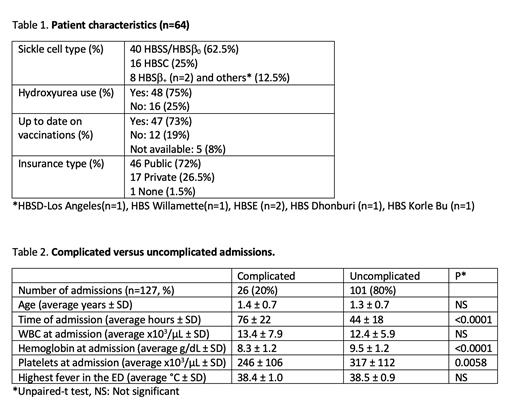Background
Due to functional asplenia, patients with sickle cell disease (SCD) are at increased risk of serious bacterial infection (SBI) with encapsulated organisms. With the advent of prophylactic penicillin, Haemophilus and Pneumococcal vaccination, this risk has decreased, though recommendations for admission in young children are not standardized and based on institutional practice. Historically, our standard at Benioff Children Hospital Oakland (CHO) has been to admit all children with SCD < 3 years with fever due to these historical concerns. We hypothesized that in a well appearing febrile cohort, the risk of complication would be very low (i.e., <3-5%), allowing liberalization of this stringent recommendation.
Methods
After IRB approval, we conducted a retrospective review of electronic medical records of children with SCD <3 years of age admitted with fever (i.e., ≥38.3ºC) from October 1 st, 2013 to May 30 th 2022 at CHO. We excluded patients who presented with fever and other complications in the emergency department (ED) that would have otherwise required admission including: 1) splenic sequestration; 2) acute chest syndrome (ACS); 3) hypoxia and/or respiratory distress; 4) vaso-occlusive crisis (VOC); 5) hemoglobin (Hb) drop ≥2 g/dL from baseline; 6) severe dehydration; 7) seizures or other neurological concerns; 8) complicated/complex medical history; 9) SARS-CoV-2 infection; 10) age <2 months; 11) soft tissue infection; and 12) UA concerning for infection.
Results
Sixty-four unique patients with 127 encounters were included with baseline features outlined in Table 1. Ninety-seven encounters were excluded due to presenting signs/symptoms. Rate of bacteremia was 1.6% (2 of 127). Twenty-six of the 127 encounters (20%, 21 unique patients) were deemed complicated, due to: 1) bacteremia (n=2); 2) splenic sequestration (n=6); 3) acute chest syndrome (n=1); 4) worsening anemia requiring transfusion (n=11); 5) pain crisis (n=1); 6) persistent fever (n=4) and 7) norovirus gastroenteritis (n=1). Eighty-five percent were in children 2 years or less. Complicated admissions were statistically longer and had lower hemoglobin and platelets at presentation than uncomplicated admissions (Table 2). There was no difference in age, white blood cell count (WBC) and maximum fever during presentation in the ED (Table 2). Fourteen of 26 complications (54%) occurred in the first two days of admission and the rest thereafter.
Conclusions
Although the rate of bacteremia was low as expected in children with SCD <3 years of age presenting to the ED with fever and without concerning presenting features, the overall rate of complications during admission for those encounters was much higher than our acceptable a priori threshold. Retrospectively, there were no easily discernible presenting features in this otherwise well-appearing cohort to determine need for admission. Complications often occurred beyond day 2 of admission. The majority of complications occurred in children ≤2 years of age; we therefore will continue to admit all children with SCD and fever ≤ 2 years of age with a low threshold for ongoing admission beyond the 48 hour rule out. Institutional standards must closely monitor for increased adverse events if utilizing more lenient ED discharge criteria in this population.
Disclosures
Agrawal:Y-mAbs Therapeutics: Membership on an entity's Board of Directors or advisory committees.


